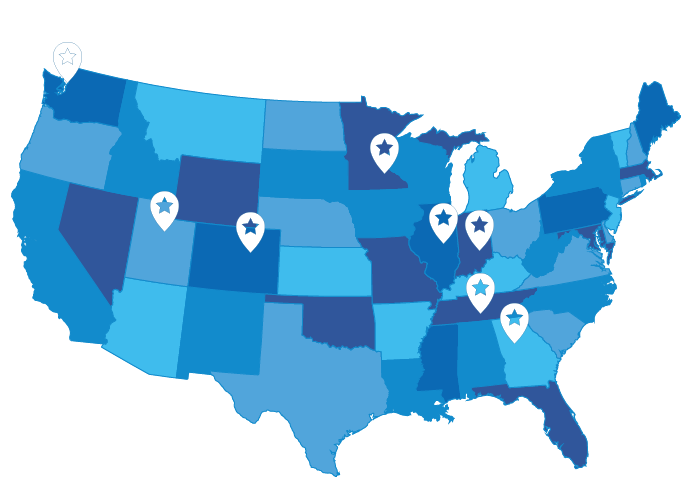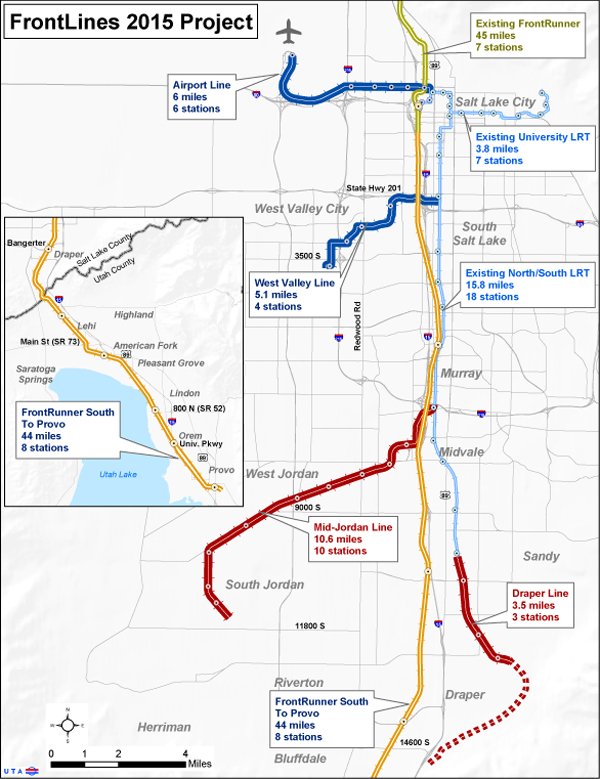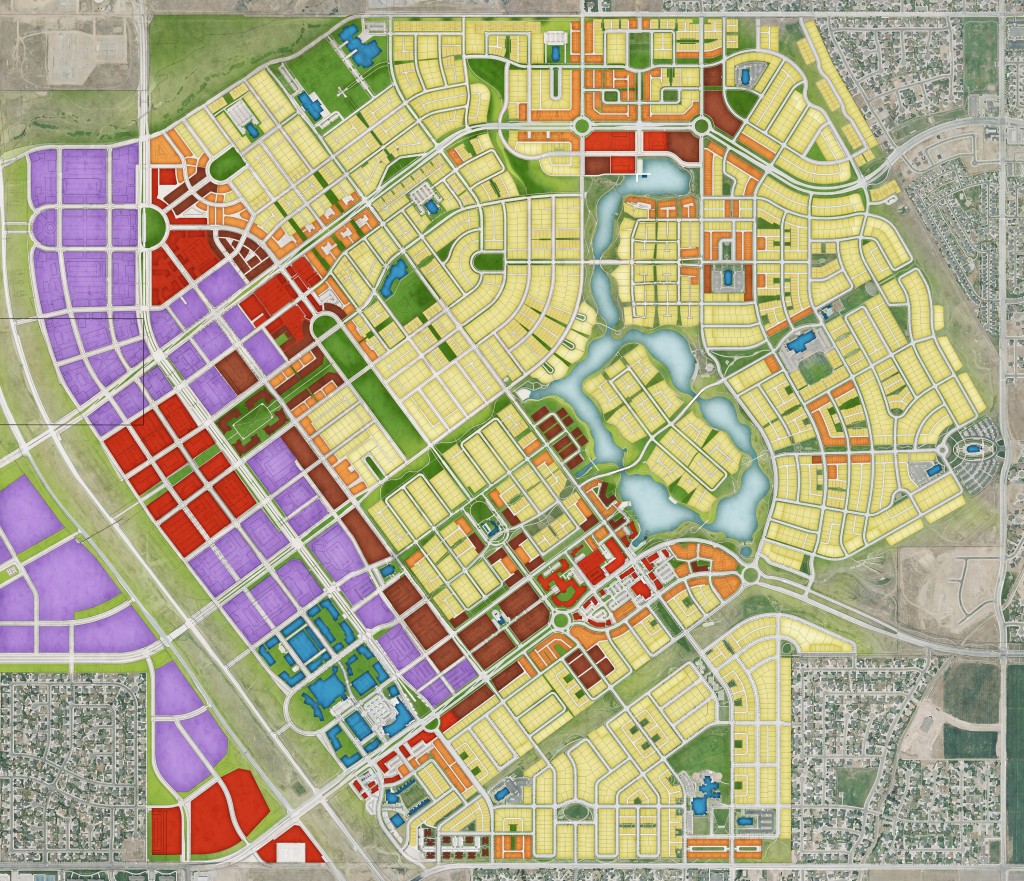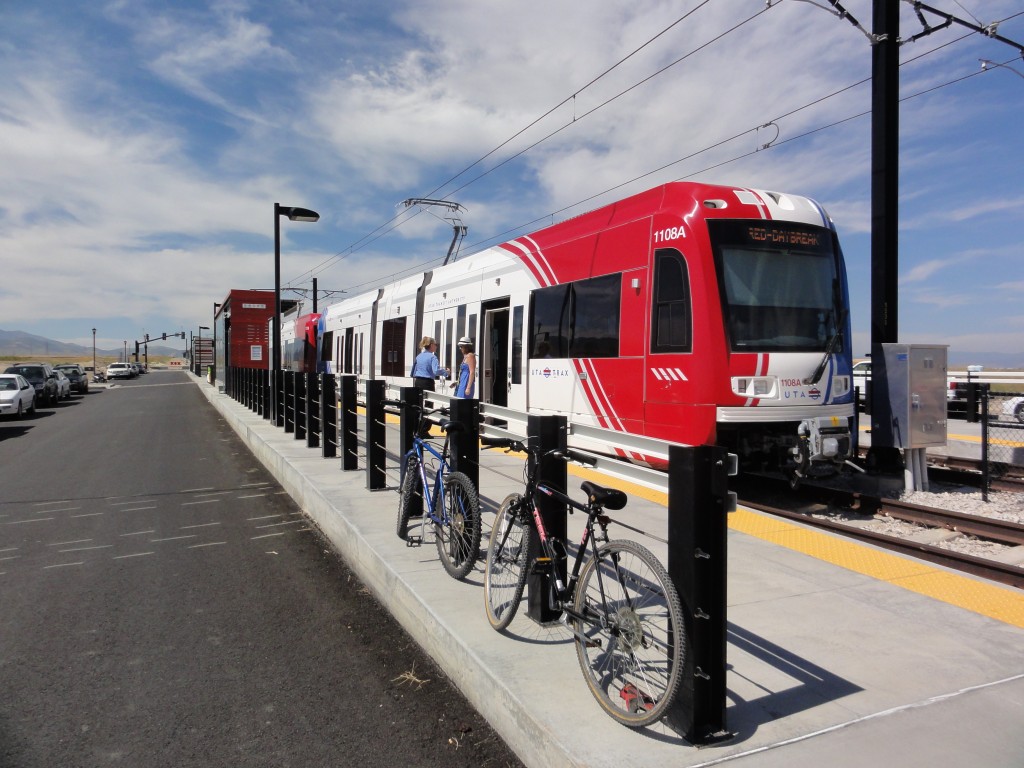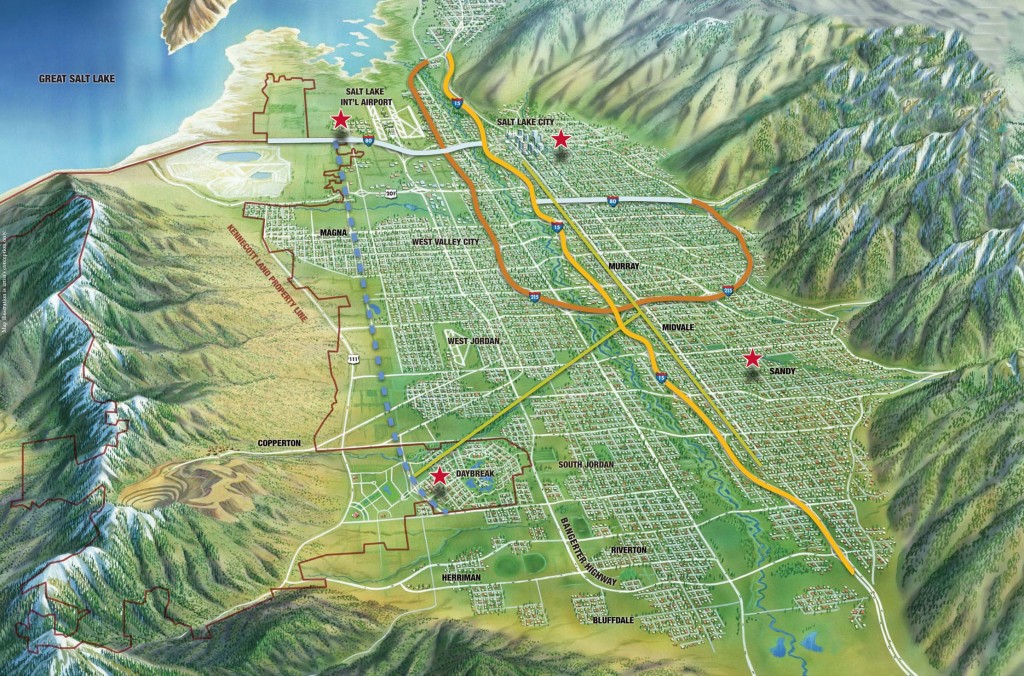Inclusive planning, bipartisan support and ambitious investments are fueling economic prosperity
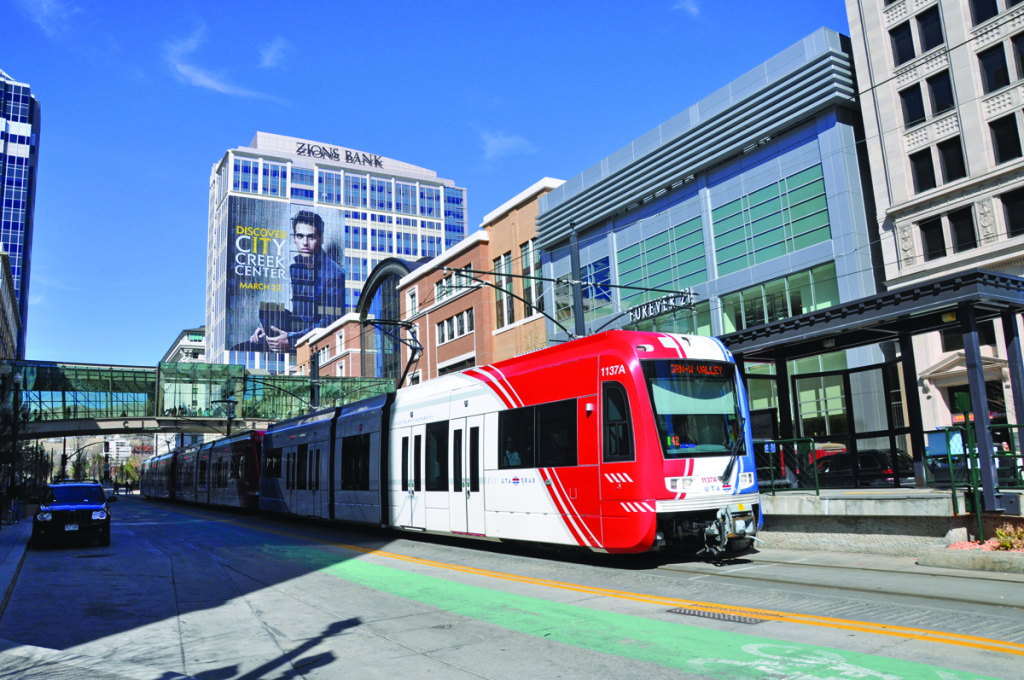
Salt Lake City’s light rail, bus and commuter rail systems have been expanded with funding from a 2007 voter-approved sales tax, which won by a two-thirds majority.
Their “special sauce”? A combination of sound fiscal decision-making, agency collaboration, and a dedication among residents to get things done for the good of the community.
One ongoing challenge for the Salt Lake City region in particular is geography. How will a growing population maintain a good quality of life in a relatively thin sliver of land?
Utah is the sixth most urban state in the country, with 80 percent of the population residing along the Wasatch Front, a metropolitan region in the north-central part of the state that includes Salt Lake City, Provo, and Ogden. Bordered to the east by the Wasatch Mountain Range and to the west by the Great Salt Lake and Utah Lake, the region provides limited space for its two million residents.
To compound the issues associated with limited space, the Wasatch Front’s population is expected to increase 60 percent by the year 2040, swelling to 3.5 million people.
Residents, planners, business leaders and their elected officials are asking the question: How to accommodate that growth while maintaining the region’s reputation as an economic powerhouse with world-class outdoor recreational opportunities?
Answers to that question began in 1987 with the founding of the Coalition for Utah’s Future. From that coalition grew Envision Utah, a nonprofit organization focused on growth issues around the state. In 1997, Envision Utah launched a two-year research effort focused on the growth along the Wasatch Front. That process engaged approximately 20,000 participants and resulted in the Quality Growth Strategy, a vision for the Wasatch Front that aimed to accommodate growth while conserving more land and water, limiting emissions associated with the region’s air quality challenges and providing more transportation and land use choices to meet market demand.
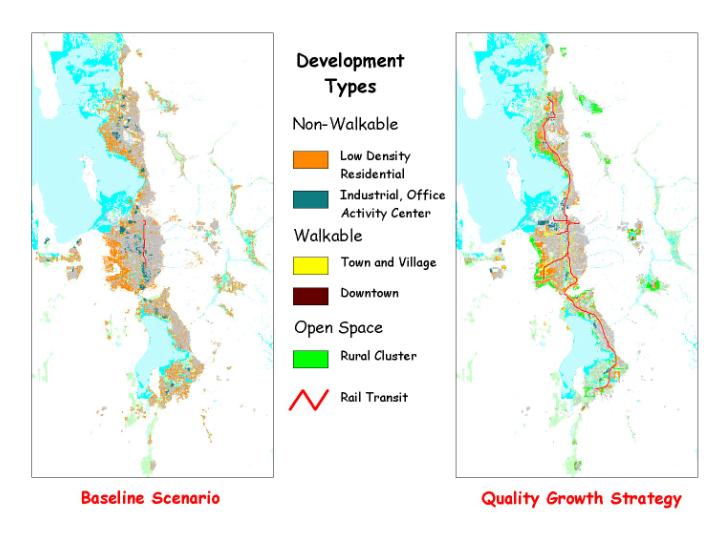
Comparing the outcomes of two possible future growth scenarios outlined in the Quality Growth Strategy from Envision Utah.
Central to the strategy is focusing more of the expected growth along key transportation corridors with current or planned transit and roadway capacity.
“Our population nearly doubles every single day with the workforce coming in and out of our downtown,” said Robin Hutcheson, transportation director for Salt Lake City. But leaders are also looking beyond just getting people from the suburbs or satellite cities into downtown each day.
“In addition to providing circulation within our downtown area for commuters, we also have the challenge of providing transportation choices to our residents, many of whom never leave the City for their daily trips. And we are catching up,” she added. “We are trying very hard to implement projects that will help the mobility within our city, not just help people to get to our city.”

Greenbike, a new bikesharing system in downtown Salt Lake City helps make last-mile connections and serves as a circulator within the downtown core.
Along with almost unprecedented citizen participation in the region’s long-range planning efforts through Envision Utah, the region’s business community has also played a leadership role in advocating for additional transportation investment in local and state transportation needs.
“The number one issue ten years ago became the infrastructure,” said Lane Beattie, president and CEO of the Salt Lake City Area Chamber of Commerce.
“We realized right up front from a business community [perspective], that if we let the infrastructure slip in our communities, we would absolutely commit economic suicide,” Beattie added. “It takes so much longer to build yourself out of a problem once you’re in, so we had to address it. The business community stepped up and said we want commuter rail, we want light rail, we want roads.”
Since the 1990s, the Utah Transit Authority (UTA) has been busy building — almost from scratch — a huge transit network comprising 140 miles of commuter rail, light rail, streetcar, and bus rapid transit. Along with the spending of various other entities, about $10 billion has been invested during the past decade in downtown redevelopment, roads and transit.
In 2010, Utah’s transportation agencies all adopted a groundbreaking Unified Transportation Plan, the first of its kind in the country.
Assembled by local government and civic leaders from across the state, this plan outlines anticipated 30-year needs for road, transit, and active transportation projects, as well as capacity and maintenance needs for Utah’s metropolitan and rural areas.
“In providing more and better transportation choices, Utah’s Unified Transportation Plan supports a robust economy and high quality of life,” said Andrew Gruber, executive director for the Wasatch Front Regional Council. “The improvements identified in the Plan support a shared vision to improve the air we breathe and to provide for a safe, affordable transportation system. The Plan also proactively addresses maintenance needs, ensuring a quality transportation system in good repair now and for future generations.”
The Unified Transportation Plan calls for a third of the state’s future transportation investments to be made on state roads, a third on local roads, and a third on transit— defined as all other modes that help provide mobility, including bicycles, walking, vanpool, buses, light rail, commuter rail, street cars, etc. Transit-oriented development is another consideration in the plan as they seek to leverage the billions of dollars they’ve invested in transit by creating opportunities for more people to live, work, and recreate in communities centered around the transit connections.
The Utah Department of Transportation (UDOT) and local communities have been balancing the need to proactively maintain the existing roadway infrastructure with the need for strategic new capacity.
In the past several years, the state has invested significant resources into upgrading the transportation network, including new investments in the Interstate 15 corridor in Utah County. And UDOT has demonstrated how to better utilize existing resources by deploying new managed express lanes on almost the entire length of I-15 from Spanish Fork in Utah County north through Salt Lake City all the way up to Layton in the north. Carpoolers and buses can use the lanes for free, and the excess capacity is sold to solo drivers via a fluctuating toll (used to fund operation of the lanes) to keep traffic moving.
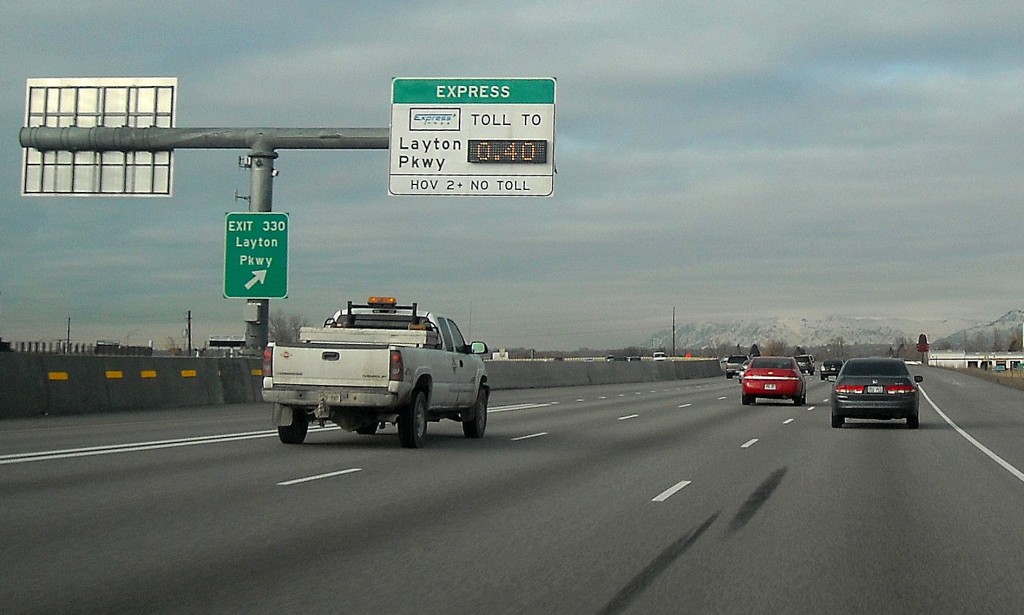
Managed lanes on I-15. Flickr photo by Garrett. /photos/countylemonade/5377476422/in/set-72157625406413061
“The Utah Department of Transportation works collaboratively with our local partners, including cities, counties and the Utah Transit Authority to provide a robust, multi-modal transportation system” said UDOT Executive Director Carlos Braceras. “Our goals include optimizing mobility, preserving our infrastructure, workings towards a goal of zero fatalities and supporting the economy.”
One of UDOT’s innovations sounds so strange that it requires a double take when you hear it the first time: bridge farming. That’s right, UDOT has experimented with the practice of “growing” their bridges offsite in sections, and then moving them into place relatively quickly with minimal disruption to traffic.

“Bridge farming” in Salt Lake City. Flickr photo by Shaan Hurley. /photos/btl/2700839269/in/photolist-
That kind of smart thinking was crucial on projects to replace bridges on heavily trafficked sections of three of the region’s core arteries, Interstates 80, 15 and 215.
In August 2013, the Utah Transit Authority completed its Frontlines 2015 Project—70 miles of new rail service over a seven-year period, finishing two years ahead of schedule and $300 million under budget. FrontRunner commuter rail now runs from Provo to Ogden. Five lines of TRAX light rail in the downtown area were extended to the suburbs, and a connecting line to Salt Lake City International Airport has been added. According to UTA, 25% of commuters arriving in downtown Salt Lake City each day now arrive by public transportation.
In addition, the S-line Sugarhouse streetcar project, supported with a federal TIGER grant, opened its first phase in December of 2013.
Federal contributions have been, and will continue to be, a crucial component of project funding. “We’ve been fortunate to acquire funds from a whole bevy of federal sources,” said Michael Allegra, president and CEO of UTA.
Salt Lake City’s commuter, light rail lines and express busses already carry the equivalent of two freeway lanes during peak traffic, and the University of Utah has reclaimed several parking lots, because more people are taking light rail to the campus. According to UTA, approximately one-third of the faculty, staff and students going to the University of Utah get there via public transportation.
“There is definitely an economic case to be made. We’re seeing more businesses choose to relocate or locate in our downtown area. And the ability to transport the workforce to the jobs is of course the most direct link to the economic engine that transportation can provide, especially for lower income residents of our community,” said Hutcheson.
While planned transportation investments were rolling along, the Salt Lake Chamber — Utah’s statewide chamber of commerce — worked with partners to create Downtown Rising, an initiative that promoted major reinvestment in Salt Lake City’s now-thriving urban core.
Further investments were also being made south of Salt Lake City. In the nearby city of South Jordan Kennecott Land began building Daybreak, a modern, walkable suburban neighborhood that boasts a variety of homes within walking distance of schools, shopping, jobs, and recreational amenities. Daybreak is expected to comprise more than 20,000 units when it’s completed. The neighborhood is now connected to the rest of the metro region and the airport via UTA’s Red Line light rail.
The Daybreak master plan at left (from Daybreak), the Daybreak TRAX light rail station at right (Flickr photo by Steven Vance) and a map of the full Salt Lake Valley showing Daybreak’s location on Kennecott’s land.
This project is one example of private sector confidence in the kind of well-planned development toward which the Wasatch Front region is moving.
“The new transit infrastructure is a crucial factor for strengthening Utah’s economy,” said Greg Hughes, UTA board member and past chair, majority whip of the Utah State Legislature and former chair of its conservative caucus.
Hughes recognizes the enormous benefits good transit service has on recruiting smart, talented workers to the Salt Lake City region — and the subsequent impact on luring other companies to come to the region.
“For instance, we saw a major tech company relocate to Utah, adjacent to a commuter rail station. This location gave them access to a workforce located all along the Wasatch Front where employees can access FrontRunner commuter rail,” said Hughes. “…If you’re anywhere in the country and believe that a successful economy is the rising tide that lifts all ships, then you need to know that tech companies aren’t married to a geographic area. Your mass transit system is a major factor in where these corporations decide to relocate and where they draw their workforce from.”

Boarding the first FrontRunner commuter train from Provo to Salt Lake City. Flickr photo by Steven Vance https://www.flickr.com/photos/jamesbondsv/8253107666
David Golden, a banking executive with Wells Fargo and co-chair for Salt Lake Chamber’s transportation initiative the Utah Transportation Coalition, agrees.
 “One thing I think we’ve proven is that an investment in transportation pays dividends for our economy and I think the citizens and leadership of our state generally understand that,” he said. “From a business community perspective, we understand how important this investment is and how beneficial it is. We are a growing state with numerous demands, but I think overall, transportation is a proven winner in this state and one that people are on board with getting behind.”
“One thing I think we’ve proven is that an investment in transportation pays dividends for our economy and I think the citizens and leadership of our state generally understand that,” he said. “From a business community perspective, we understand how important this investment is and how beneficial it is. We are a growing state with numerous demands, but I think overall, transportation is a proven winner in this state and one that people are on board with getting behind.”
Golden points to an economic analysis that found a $1.94 gain in gross domestic product for every $1 invested in the Unified Transportation Plan. “That’s a winner,” he said.
“Utah sees its transportation infrastructure—rails, roads, buses—as a way to stay competitive, not just in the western United States, but globally,” said Hughes. “The world is flat. Our workforce—those students who are graduating from college and entering the workplace—they are not just competing regionally any longer. They’re competing on a world stage. Utah wants to be in that game. We want people to live and work in the state of Utah and be competitive.”
Through a lot of consensus-building and the cooperation of the public and private sectors on the Wasatch Front, the region’s leaders have laid the groundwork for economic prosperity for years to come. They’ve cultivated a heritage of leadership in the local business community. They’ve engaged thousands of citizens to think about what kind of place they want the Salt Lake City region to be decades down the road — and they’ve supported the vision with their tax dollars.
“We’ve still got more work to be done in investing for our future growth,” said Beattie. “The secret sauce that got us to this point will need a bit of seasoning to ensure we continue to invest prudently in our infrastructure and prosper as a region for years to come.”
Share this story:





